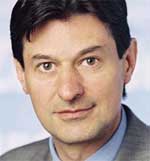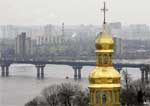Despite continuing political upheaval, many countries in Central and Eastern Europe are more concerned about reining in their buoyant economies than surviving the global economic downturn.
 |
|
Although the politics in Warsaw may be “noisy,” the macro-economic fundamentals are extraordinarily good. |
Countries in the region fall into two main categories: those with commodities and massive current account surpluses, and those without commodities and that have significant current account deficits. The former group is dominated by Russia and Ukraine, the two powerhouses of the region. The latter comprises a large number of countries, of which the largest are Poland, Hungary and Romania, most of which have joined the European Union and are today benefiting from inflows of European funding and a boost in trade with their eurozone partners.
 |
|
Brezinschek: We expect banking sector growth [in Ukraine] to decelerate. |
The vigor of these economies stems from the relatively recent arrival of market forces and capitalist structures. These are no more than 18 years old and were created in the wake of the break-up of the Soviet system. Unburdened by the inefficient legacy of many Western organizations, companies from Central and Eastern Europe are pushing into the markets of their older, more hidebound neighbors.
The politics of the Eastern European dynamos do not always match their economies, however. Many suffer from weak democracies that do nothing to enhance investor confidence. Governments in countries such as Ukraine, Hungary, Poland and Romania change frequently, while many of the same individuals remain in power. One economist concluded, “There is a lot of political noise in Central and Eastern European countries, but the process of convergence has been very successful.”
This economist cites the case of Poland. “There has been a new finance minister every year, parties have disappeared, and others have emerged,” he says. “This is a very unstable environment, but the macro-economic structure has been extraordinarily good. Even the fiscal situation has not got out of control. The politics are noisy, but they don’t matter as much as you might have thought.”
Russia is an exception. Its reputation, under something of a cloud following controversial military and security activity and a wrench in relations between Moscow and London, was enhanced by the smooth ascendancy of Dmitry Medvedev to the presidency, following national elections that saw Vladimir Putin move across from president to prime minister. The economy has been run with the same degree of centralized discipline. Impressive control of oil revenues and expansion of the real economy has led Moody’s ratings agency to predict an upgrade from BAA2 to BAA1.
Economists are treating alarmist headlines about political instability across the CEE region with skepticism. They say that the underlying economies show the region to be in a catch-up phase and enjoying considerable growth. Numbers range from 4% to 10%, for most, although Hungary struggles to reach the lower end of the bracket. These countries are also importing large amounts of technology, and that is straining their current accounts. But statistics that would be unacceptable in their western neighbors in the eurozone cause hardly a ripple in countries to the east. Their expansionary niche is a very comfortable place to be during a period of global economic turmoil.
The downside of the region’s rapid growth is that it has triggered rising inflation. Juraj Kopian, the head of macro and fixed income for Erste Bank in Vienna, says, “Inflation is a problem across the region.” The factors driving inflation range from external forces, such as rising food and fuel prices, to depreciating local currencies. Inflation in the Czech Republic, for example, has soared to 8.4% year-on-year—sharply higher than its central bank’s 2% target. Polish inflation is over 5% year-on-year and will most likely not reach the central bank’s target before the end of 2009. Bulgarian inflation stands at 12.2%, a factor that Raiffeisen Research notes may be influenced by tax changes.
In Ukraine the central bank is tightening money supply in an attempt to rein back inflation, but the impact is likely to be limited, says Peter Brezinschek, the chief economist at Raiffeisen. “The Ukraine authorities are trying to reduce inflationary pressures in the economy by sticking to relatively tight fiscal and monetary policies. But the effectiveness of these measures in the short-term is limited. High and volatile inflation is harming business planning by entrepreneurs,” he says.
Hungary Continues To Flounder
In the region, the most vulnerable of the larger economies to inflation is Hungary, where the government has struggled to win acceptance for tighter fiscal policies. Dietmar Hornung, Moody’s Investors Service analyst for Central and Eastern Europe, says: “Hungary has experienced inappropriate macro-economic management. There has been a very expansionary fiscal policy. They are trying to rein that in, but it is not popular.” That may be an understatement. Hungary’s social liberal coalition collapsed as a result of policies designed to curb the money supply. The government that replaced the coalition has weakened monetary control, leaving observers concerned about the country’s future monetary stability.
 |
|
Kiev, Ukraine: One of CEE’s economic power houses, but inflation and economic relations with Russia remain “flies in the ointment.” |
Raiffeisen Research is critical of Hungarian economic management and predicts future political turmoil as a result. “The fiscal austerity measures helped to cut the budget deficit from 9.2% [of GDP] in 2006 to below 5% by 2008,” Brezinschek says. “But these measures were far too focused on tax hikes versus expenditure cuts. The socialists are growing unhappy about the performance of the government and the party’s dwindling popularity. It is speculated that President [Ferenc] Gyurcsány will be removed before the 2010 elections.”
Erste Bank’s Kopian is more positive on Hungary, however. “The new government’s measures have worked quite well in terms of consolidation,” he says. “The Hungarian economy has had a problem with current account deficits for many years, and now the situation has improved significantly. Hungary is not the dark horse, but it is not the favorite in terms of growth and convergence. The Hungarian reforms will bear fruit, and Hungary will return to 4% to 5% growth in two years.”
There are signs that inflation across the region has, in any case, peaked, and central banks may now be able to look forward to a more stable monetary environment. According to Kopian, tightening monetary policy and falling GDP growth levels will begin to bite into inflation from the second half of the year.
Management of the money supply has been particularly sensitive in Slovakia, which joins the eurozone in January 2009. Its interest rate stands above the European central bank level, and it has decided to maintain current levels and risk inflation, rather than raise them for the short term, before it has to cut them again to ECB levels.
 |
|
Kopian: Hungary is not the dark horse, but it is not the favorite in terms of growth and convergence. |
Painful Adjustments Loom
For the populations of many countries in the region that have grown accustomed to an improving standard of living, policies aimed at reducing growth will be extremely unpopular, says Hornung. He cites the case of Romania where, he says, “If GDP growth has to come down to adjust to the situation, this is unlikely to be welcomed. The effects may be painful.”
Kopian is more optimistic, commenting that Romania’s free-floating currency could help it weather future upheaval. “Having a free float might cause higher volatility, but the more flexible exchange rate is an advantage during global financial turmoil,” he says.
The greatest risk of speculation and instability is in the region’s smallest economies around the Baltic Sea, in particular Latvia. Large amounts of foreign investment have been poured into these countries over the past five years, but the economies have been too small to absorb it into the real economies. As a result, the money has fueled sharp rises in property prices, which are now at potentially unsustainable levels. “The Latvian currency has not depreciated, and there is much greater risk of speculative attacks on the currency,” says Kopian. “The Baltics are at risk of speculation. They are more vulnerable and risky than Romania.”
Kopian believes that Latvia would be in great danger of default without the support of a group of Swedish banks, which together control much of the Latvian banking system. These banks have “provided a facility to the local banks and can intervene in favor of the local currency,” he says. “They can purchase Latvian currency to keep the exchange rate stable.” Effectively, he adds, the management of monetary policy is shared between the Latvian central bank and the Swedish parent banks. Moody’s has a pessimistic outlook on the prospects for the Baltics.
Hornung says that if the countries cannot finance their current account deficits, “they have a big problem. The adjustment will come through lower growth, which will lead to lower domestic demand. That is what we expect from the Baltics, Bulgaria and Romania. These adjustments will not be nice in economic terms, but we do not see macro-economic crisis, at least not of the type that will lead to a sovereign default.”
UKRAINE: A POWERHOUSE ON SHAKY FOUNDATIONS
Ukraine has been one of the CEE’s economic powerhouses, a role it shares with its less than well-disposed neighbor Russia. The country’s economy has grown at an average of 7.8% over the past five years, and despite suffering energy price shocks, political instability and global financial turmoil, Ukraine’s GDP is still growing by 7.3% year-on-year. The fiscal deficit remains low, at about 1.1% of GDP, despite debilitating factors such as a privatization process whose speed has been disappointing, lower tax receipts and a relaxation of fiscal discipline due to political instability.
The fly in the ointment for Ukraine is inflation, which has soared to over 22% year-on-year in 2008—the highest rate since 2000. Rapid wage growth, higher prices on imported energy resources and other commodities, poor agricultural performance and loose monetary conditions all contributed to the inflationary surge. At the same time, Ukraine’s central bank has been selling the hryvnia (Ukraine’s currency) to maintain its peg to the US dollar. Raiffeisen Research expects the bank to introduce greater exchange rate flexibility, however, which will allow the currency to appreciate against the dollar.
Ukraine’s dependence on Russia’s gas supplies accounts in part for its expanding current account deficit, which stands at 4.2% of GDP and is expected to reach 6.2% by the end of this year. The ugly dispute between Russian gas company Gazprom and Ukraine that resulted in a 45% gas price hike in 2006 and a further 37% increase at the beginning of 2007 has exacerbated the problems.
Economic relations with Russia are at the heart of an acute division in Ukrainian politics between those favoring closer links with Russia and those who want to build stronger ties to the West. The pro-Russian group currently holds the ascendancy in Ukrainian politics, but recent elections show an electorate split on the issue. The political issue is particularly sensitive as Ukraine is exporting increasing amounts of its goods—primarily steel and manufactured industrial products—to Russia. Russia imported 22.5% of Ukrainian exports in 2006 and 25.7% in 2007.
Dietmar Hornung of Moody’s Investors Service is anxious about the fragmented political scene in Ukraine but believes it will not prevent an imminent upgrade to investment grade. “You have to assume that the political noise is not so terrible that it will inhibit economic development,” he says. Moody’s is expected to raise to investment grade the country’s B1 rating shortly.
Offsetting the economic drag of Ukraine’s current account problem is the massive inflow it receives of foreign direct investment. In 2007 the country received $7.9 billion in FDI, up 67% from the previous year and an all-time record. This inflow has benefited, among others, local stock markets, which grew by 135% over the year. How they will perform this year, though, is debatable. Tough global conditions may lead to higher energy costs and weaker investment flows, which could trim GDP growth to a still very creditable 5.5%. Private consumption will continue to drive the economy, although even this will be pinched as banks are forced by credit conditions to rein back on lending.
This will not be before time. Annual credit growth had reached an unsustainable 66% a year for the three years between 2005 and 2007. Some tailing off must be predicted, according to Raiffeisen Research. “We expect banking sector growth to decelerate due to gradual market saturation, reduced access to foreign funding, less favorable macro-economic conditions and tighter regulation,” Raiffeisen’s chief economist Peter Brezinschek says.
Ukraine’s economy has built up a considerable head of steam. For all its success, there may be some pain as its politicians are forced to apply the brakes.
Nick Kochan



